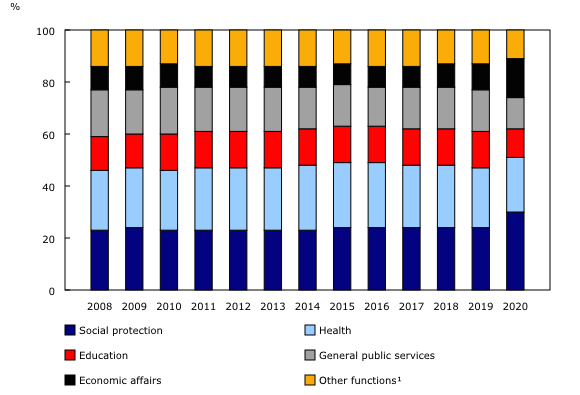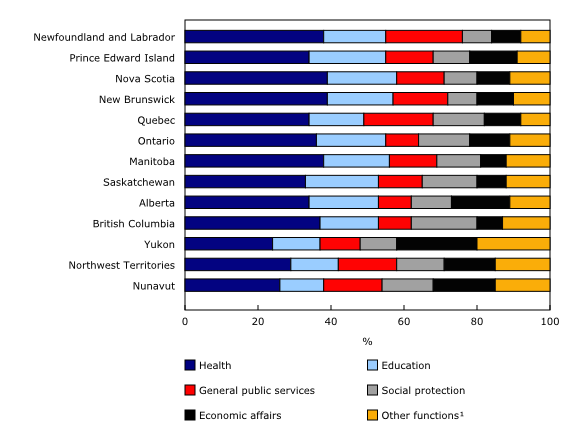Expenses of government classified by function, 2020
Archived Content
Information identified as archived is provided for reference, research or recordkeeping purposes. It is not subject to the Government of Canada Web Standards and has not been altered or updated since it was archived. Please "contact us" to request a format other than those available.
Released: 2021-11-26
For the first time, spending by all levels of government in Canada surpassed the $1 trillion mark. Spending increased by $267.4 billion from 2019, for a total of $1,069.0 billion in 2020. This was a 33.4% increase from the previous year and the largest recorded increase in Canadian government spending. This was largely a result of the government's response to the COVID-19 pandemic.
Social protection, economic affairs and health care were the largest contributors to spending increases in 2020. Governments in Canada spent $18,574 per person in 2020 in these categories, compared with $12,042 in 2019.
Canada Emergency Response Benefit drives increase in social protection spending
The consolidated Canadian general government—that is, the federal, provincial, territorial, local and other government entities combined—increased spending on social protection by 69.9% in 2020, to $325.3 billion. Social protection remained the largest expense of the Canadian general government, at almost one-third (30.4%) of total spending. Of the $267.4 billion increase in total spending, social protection accounted for half (50.1%).
Social protection includes programs such as Old Age Security, family benefits, disability payments and unemployment benefits. This increase in social protection spending in 2020 (+$133.9 billion) was primarily driven by higher spending on unemployment (+$106.5 billion), which was largely driven by the Canada Emergency Response Benefit and the subsequent Canada Recovery Benefit. Family and children benefits (+$9.3 billion) and protection of vulnerable persons (+$8.4 billion) also contributed to the increase.
Canada Emergency Wage Subsidy doubles economic affairs spending
Spending on economic affairs—which refers to economic activities such as agriculture, energy, mining or transport—rose 109.1% from 2019 to $162.5 billion. It was the second-largest contributor to increased government spending in 2020. The bulk of the increase in 2020 was attributable to spending on general economic, commercial and labour affairs, which rose 444.7% from $17.9 billion in 2019 to $97.2 billion in 2020. The Canada Emergency Wage Subsidy was primarily responsible for the majority of this increase.
As a share of total government spending, economic affairs took the place of education as the third-largest expense in 2020. Economic affairs accounted for 15.2% of total government spending, compared with 9.7% in 2019. 2020 was the first year in which governments in Canada spent more on economic affairs than on education.
Health care's share of spending decreases
Spending on health care rose 17.2% to $220.8 billion, accounting for 20.7% of total government expenses. Despite an overall increase, health care's share of total government spending was down in 2020 from the previous year, as it did not increase at the same rate as the shares of spending on social protection and economic affairs.
The $32.4 billion increase in health care spending was primarily attributable to increased spending in hospital services (+$19.6 billion), public health services (+$6.0 billion) and outpatient services (+$4.3 billion).
Spending at the provincial, territorial and local levels of government driven by health care
Spending on health care by provincial, territorial and local governments combined grew 15.9% in 2020, maintaining its position as their largest expense, at over one-third (35.2%) of their total spending.
Per capita spending on health care was the highest provincially in Newfoundland and Labrador ($6,589), New Brunswick ($5,982) and Nova Scotia ($5,835). The lowest health expenses per capita were in Prince Edward Island ($4,877), British Columbia ($5,372) and Ontario ($5,400).
Based on an average of the provinces, hospital services accounted for the largest proportion of health care expenses, at two-thirds (66.8%), followed by outpatient services (15.6%) and medical products, appliances and equipment (6.8%).
British Columbia increases social protection spending in response to the COVID-19 pandemic
British Columbia reported unmatched growth in social protection spending in 2020, up 48.7% to $13.4 billion ($2,576 per capita in 2020 compared with $1,745 per capita in 2019). This increase in social protection spending was a result of the province's response to the COVID-19 pandemic, namely the BC Recovery Benefit and the BC Emergency Benefit for Workers.
Among provincial and local governments, spending on social protection on a per capita basis was highest in Saskatchewan ($2,632) and British Columbia ($2,576), and lowest on a per capita basis in New Brunswick ($1,267) and Nova Scotia ($1,314).
Ontario and Quebec increase support for businesses impacted by the COVID-19 pandemic
Total provincial, territorial and local government spending on economic affairs rose 10.2% to $64.6 billion in 2020. This increase was largely attributable to higher spending on general economic, commercial and labour affairs (+$3.2 billion), transport (+$1.5 billion) and energy (+$1.1 billion).
The increase in spending on general economic, commercial and labour affairs was led by Ontario (+$2.1 billion) and Quebec (+$0.6 billion). The growth in Ontario was mainly attributable to its Small Business Support Grant. Similarly, Quebec's increase was mainly the result of its COVID-19 relief programs for businesses.
On a per capita basis, provincial spending on economic affairs was highest in Alberta ($2,558), Prince Edward Island ($1,851) and Quebec ($1,761), and lowest in Manitoba ($953), British Columbia ($1,129) and Nova Scotia ($1,268).
Federal government boosts defence and education spending
The federal government increased spending on defence by 28.7% compared with 2019 to $23.9 billion in 2020. This growth is largely the result of an agreement reached with the Canadian Armed Forces for a retroactive, lump-sum pay increase dating back to April 1, 2018.
The federal government of Canada spent $10.0 billion on education in 2020, a 25.0% increase from the previous year. The major contributor to this increase was the doubling of Canada Student Grant amounts, aimed at providing assistance to students during the pandemic.
Note to readers
The COVID-19 outbreak, declared a pandemic on March 11, 2020, has led to economic disruptions across the globe. The Canadian federal, provincial, territorial and local governments took unprecedented economic measures to help limit the spread of the virus. The most recent Canadian Classification of the Functions of Government (CCOFOG) data for the current fiscal year, ending March 31, 2021 (2020 reference year) includes the COVID-19 fiscal impacts.
The CCOFOG organizes government expenses into their main socioeconomic functions. This information provides an important picture of how governments spend money and the role governments play in delivering services.
The CCOFOG is a variant of the international functional expenditure classification that was developed by the Organisation for Economic Co-operation and Development. The CCOFOG replaced the Financial Management System that was used by Statistics Canada until 2008.
Currently, CCOFOG data exclude the acquisitions of non-financial assets and the consumption of fixed capital expenses. Future data improvements may include the functionalization of capital expenditures and the consumption of fixed capital.
The consolidated provincial, territorial and local government (PTLG) estimates are often used for provincial and territorial comparisons since there can be different delineations of responsibilities between levels of government in various jurisdictions. These estimates combine provincial and territorial governments, health and social service institutions, universities and colleges, municipalities and other local public administrations, and school boards, while removing interparty transactions. The consolidated Canadian general government estimates combine the federal government data with PTLG data. They exclude data for the Canada Pension Plan and the Quebec Pension Plan, and for federal and provincial government business enterprises.
The constitutional framework of PTLGs in the territories differs from the framework in the provinces. This leads to differences in the roles and financial authorities of government. These differences, as well as other geographic, demographic and socioeconomic dissimilarities between the North and the rest of Canada, give rise to significant differences in government finance statistics.
Since the size of PTLG estimates varies significantly across jurisdictions because of different population sizes, per capita data are used for expense comparisons. Per capita data are based on population estimates for Canada, the provinces and the territories, available in table 17-10-0009-01.
Annual data correspond to the end of the fiscal year closest to December 31. For example, data for the federal government fiscal year ending on March 31, 2021 (fiscal year 2020/2021) are reported as the 2020 reference year.
Products
The infographic "Government spending by function, 2020/2021," which is part of Statistics Canada — Infographics (11-627-M), is now available.
The Canadian Classification of Functions of Government classification structure and descriptions are now available under the related information module of the Statistics Canada website.
Additional information can be found in the Latest Developments in the Canadian Economic Accounts (13-605-X). The User Guide: Canadian System of Macroeconomic Accounts (13-606-G) is also available. This publication has been updated with Chapter 9. Government sector accounts in the Canadian System of Macroeconomic Accounts.
Contact information
For more information, or to enquire about the concepts, methods or data quality of this release, contact us (toll-free 1-800-263-1136; 514-283-8300; infostats@statcan.gc.ca) or Media Relations (statcan.mediahotline-ligneinfomedias.statcan@statcan.gc.ca).
- Date modified:



